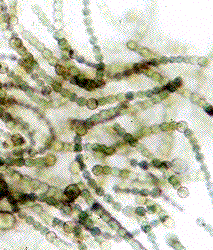The Oxygen Revolution
Cyanobacteria has been tremendously
important in shaping the course of evolution and ecological change throughout
earth's history. The oxygen atmosphere that we depend on was generated
by numerous cyanobacteria photosynthesizing during the Archaean and Proterozoic
Era. The earth's atmosphere before that time was of a different chemistry
and unsuitable for life as we know it. Cyanobacteria
was the first organisms that used H2O
instead of H2S
or other compounds as a source of  electrons
and hydrogen for fixing CO2
. They were able to synthesize organic compounds from water and CO2
By releasing Oxygen as a by-product of their photosynthesis they in affect
changed the earth's atmosphere. Cyanobacteria lived in colonies that
formed stromatolites, and evolved at least 2.5 BA. Early cyanobacteria
inhabited marine sediments where Archean banded iron formations were deposited
(consisting of reddish layers rich in iron oxide It is thought that
when early cyanobacteria released oxygen, it reacted with dissolved iron
ions, which precipitated as iron oxide. This reaction would have
prevented any accumulation of free
electrons
and hydrogen for fixing CO2
. They were able to synthesize organic compounds from water and CO2
By releasing Oxygen as a by-product of their photosynthesis they in affect
changed the earth's atmosphere. Cyanobacteria lived in colonies that
formed stromatolites, and evolved at least 2.5 BA. Early cyanobacteria
inhabited marine sediments where Archean banded iron formations were deposited
(consisting of reddish layers rich in iron oxide It is thought that
when early cyanobacteria released oxygen, it reacted with dissolved iron
ions, which precipitated as iron oxide. This reaction would have
prevented any accumulation of free  oxygen
for possibly a few million years until precipitation exhausted the dissolved
iron. This would have caused the oceans to become saturated with
oxygen and gas out to accumulate in the atmosphere. This is shown
by large deposits of iron rich rocks that were rusted red by oxidation
with atmospheric oxygen beginning approximately 2BA. The change into an
oxygen atmosphere created a crisis for Precambrian Cyanobacteria because
oxygen attacks the bonds of organic molecules. The corrosive atmosphere
that prokaryotes had essentially created likely caused the extinction of
some of the species unable to cope. The surviving species lived in
habitats that remained generally anaerobic
oxygen
for possibly a few million years until precipitation exhausted the dissolved
iron. This would have caused the oceans to become saturated with
oxygen and gas out to accumulate in the atmosphere. This is shown
by large deposits of iron rich rocks that were rusted red by oxidation
with atmospheric oxygen beginning approximately 2BA. The change into an
oxygen atmosphere created a crisis for Precambrian Cyanobacteria because
oxygen attacks the bonds of organic molecules. The corrosive atmosphere
that prokaryotes had essentially created likely caused the extinction of
some of the species unable to cope. The surviving species lived in
habitats that remained generally anaerobic